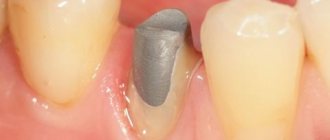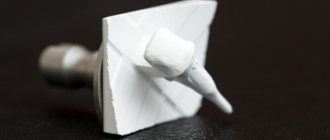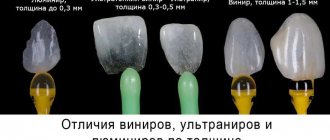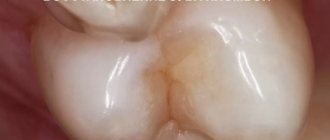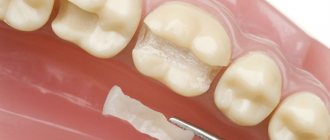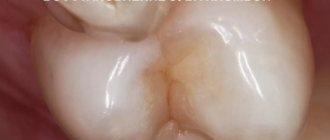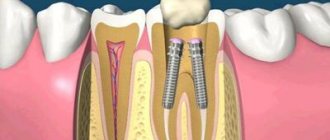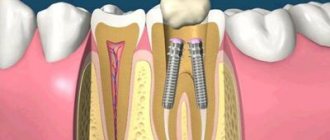Sometimes patients ask dentists: which is better, a pin or an inlay, and what is better to restore a damaged tooth? Despite the fact that these structures are somewhat similar and are intended for the same purpose - restoring severely damaged teeth while preserving their own roots - they still have a number of differences. To make it easier for the patient to decide, we will analyze the pros and cons of pins and inlays.
Content
- Details about the pin
- Details about the tab
- Materials for production
- What the inlay and pin have in common
- Differences
- What to choose - pin or tab
Currently, dentists offer many options for prosthetics and dental treatment. Modern technologies can solve almost any problem. It is important to choose the best option for a particular case. If treatment of a decayed tooth is required, the choice is between an inlay and a pin.
PROMOTION
Dental restoration, installation of fillings
from 2200 rub.
Watch the video: Dental crown on a core tab
Notice
: Undefined variable: post_id in
/home/c/ch75405/public_html/wp-content/themes/UltraSmile/single-item.php
on line
45 Notice
: Undefined variable: full in
/home/c/ch75405/public_html/wp-content /themes/UltraSmile/single-item.php
on line
46
Rate this article:
crown
Pin
This is a rod installed in the root of the tooth to strengthen it and ensure subsequent treatment. It is installed when there is severe destruction, when no more than half of the root remains. The materials used for manufacturing are polymers or metals. A serious disadvantage of metal pins is the need to greatly expand the root canal, as a result of which its strength decreases. Fiberglass pins do not have this drawback and are similar in characteristics to natural dentin.
When choosing a manufacturing material, we proceed from specific requirements:
- For prosthetics of the front teeth, fiberglass is used;
- Metal products are intended for chewing units with severe destruction;
- Carbon fiber is a universal option, suitable for any teeth.
There are two types of fastening:
- Passive – on dental cement, without load on the root;
- Active - the pin is screwed into the root using a thread.
Anchor pins
A great variety of anchor pins are used in dentistry:
- by material of manufacture: titanium, steel, brass, fiberglass;
- according to the method of fixation: active (with an active sharp thread, like a self-tapping screw), passive (smooth, stepped ribbed) and something in between (with a smooth blunt thread);
- in shape: cylindrical and conical (with different tapers);
- In addition, each manufacturer produces pins of its own original design in different sizes and claims that its pins fit all pins.
But such diversity does not confuse dentists. Anchor pins appeared on the Russian market quite a long time ago, and each of us already clearly understands the indications and contraindications for this or that type of pin. Anchor pins significantly expand the dentist’s capabilities and can be used both for tooth restoration using photopolymer material, and for restoring the “stump” of a tooth for a crown.
Tab
This is also a prosthetic design that imitates part of a tooth. Used for teeth located behind the canine teeth.
There are:
- Restorative inlays - to recreate the correct shape, bite and natural shade of the tooth;
- Stump inlays are placed under the crown and serve as the foundation for it.
The difference from the pin is in the device - the inlays consist of two parts - the pin itself and an element that replicates the tooth. The manufacturing process takes place under pressure at high temperatures. The root part is an attachment for the root and looks like a rod. The upper element follows the shape of a crown.
Comparing methods: which is better - a stump tab or a pin
So, the question arises, which is better - a stump or a pin? We conducted a brief analysis by comparing the advantages and disadvantages of both prosthetic methods. All characteristics, pros and cons are placed in the table for convenience.
| Pin | Stump tab | |
| Number of doctor visits | 1 visit | 2 visits – during the first, impressions are taken and the tooth is prepared |
| Manufacturing | Pins are template structures | Inlays are created individually in the laboratory |
| Materials | Alloys of inexpensive metals | Ceramics, metal alloys, precious metals, zirconium dioxide |
| Possibility of developing allergies | High | Low, since hypoallergenic materials can be selected |
| Possibilities of prosthetics | The crown is built up on a post using composite materials | Various materials are used: composite building, or crowns (metal-ceramics, ceramics, zirconium dioxide) |
| Aesthetics of prosthetics | Medium – the metal base will be visible, the extended tooth will be noticeably darker | Very high due to the exact repetition of tooth anatomy and the choice of snow-white aesthetic materials |
| Main advantages | Affordable price, possibility of crown repair directly in the patient’s mouth | Root protection from destruction, high aesthetics, long service life |
| Main disadvantages | Rapid destruction of the root under load, relative aesthetics, short service life | High price |
| Life time | No more than 3-5 years | From 3-5 years and above |
| Price | From 4-5 thousand rubles including extensions | From 10 thousand rubles + crown |
To summarize, then, of course, it is worth giving preference to stump inlays. Such dentures ensure the reliability and functionality of the restored tooth. They can last for decades and the tooth will look like a natural one. But inlays are noticeably more expensive, so you need to make a choice primarily based on the condition of the tooth and your budget.
Material of manufacture
A variety of materials can be used, including:
- Metals and composites are the most popular option, they are easy to manufacture, durable and have an affordable price;
- Ceramic - similar to natural tooth enamel, the most aesthetic option;
- Zirconium - combines the best qualities of the previous options - they are aesthetically pleasing and durable, but are not very popular because they are very expensive.
How it is made
What stages must be completed in order for a patient to have a high-quality stump prosthesis installed?
The specificity of the installation of stump inlays is the individuality of their production for each clinical case.
Before installing these structures, thorough sanitation of the mouth, filling of the canals and removal of the destroyed pulp in them is required.
Main stages of the process
- The orthopedist prepares the dental cavity for installation of the inlay.
- Then the specialist selects the optimal type of material, taking into account the basic parameters of the desired material (shrinkage, hardness, bioinertness, residual elasticity, thermal conductivity).
- The orthodontist makes impressions of the patient’s jaws to ideally “fit” the prosthesis into the dentition (with the obligatory consideration of antagonist teeth). The blank model is sent to the dental office.
- The variability in the manufacture of the prosthesis must be taken into account: single-root or multi-root (depending on the anatomy of the tooth being restored).
- The dentist makes a prosthetic model from the material selected by the orthodontist. Then a wax model is made from the plaster sample. Only after this do they proceed to the manufacture of a finished stump prosthesis from the selected material (metal, ceramics, composite).
- The structure is covered with a special corrective shell and sent to the doctor.
- In the dental office, the doctor processes the dental cavity and the finished inlay. After this, the prosthetic model is installed on the patient.
- Hiding the stump model of the prosthesis under a crown or bridge.
Differences
- The pin puts pressure on the root of the tooth, which can cause it to become loose; there is pressure on adjacent teeth, and the inlay eliminates this load.
- Time of use - the pin can be used for up to 3 years, the inlay - much longer, almost 10 years.
- The pin is a single design, but the tab can separate.
- It is not difficult to make a pin, but to make an inlay, laboratory specialists are involved and special studies are carried out.
- The installation of the pin is carried out in one visit to the dentist; to install the inlay, you will have to visit the doctor at least twice.
- If the tooth has a crooked root, you can only use an inlay.
- The cost of an inlay is significantly higher than a pin.
- Preparing the tooth for the installation of a pin is relatively gentle; in order to install the inlay, a large amount of tissue is removed.
Advantages of stump inlays
- maximum reliability of the “root - stump - crown” system;
- proportional load on the tooth when chewing;
- service life of the structure.
A number of indications have been developed for the stump inlay. Its use is possible:
- in case of abnormal location or formation of a tooth;
- with seriously damaged teeth (more than 70%) in the coronal part;
- if it is necessary to strengthen the tooth before installing a crown;
- in cases where it is impossible to restore the crown using other methods (filling, etc.);
- for supragingival dental defects of any origin;
- for supporting a bridge (for strengthening);
- in a situation of preserving a sanitized dental canal;
- for splinting in case of periodontal pathologies.
Price
The stump model of the prosthesis is not a cheap dental structure. Its cost may vary from one dental office to another. The most inexpensive is the metal model (on average from 2,000 to 3,000 rubles). A prosthesis made of pressed ceramics costs about 12,000 rubles. And most of all you have to pay for the zirconium dioxide inlay (about 15,000 rubles).
If your tooth is damaged, but its root is not damaged, do not worry! Modern designs in the form of a stump tab will help you preserve and strengthen a hopeless tooth.
Sources used:
- I. Yu. Lebedenko, Orthopedic dentistry, 2012
- Seifollahi M. Preparation of lateral teeth for all-ceramic inlays
- https://medicine.wustl.edu/
How is the treatment performed?
Treatment is carried out in stages.
- Diagnosis of tooth condition. The length of the root must exceed the height of the crown, the walls must have a thickness of at least 1 mm. Inflammation, cysts and other pathologies are excluded. This is very important, since the stump can only be removed with the tooth.
- Preparation of tissue under the inlay to a height of 1-2 mm above the gum edge.
- Taking an impression and sending it to the laboratory.
- Installation. First, additional pins are cut off, which are located on top of the insert. They are broken off after installation, the surface is polished. Then the channels are filled with a cementitious composition, the material is applied to the pins, and the inlay is fixed.
- Preparing the tooth for fixation of the crown and then installing the crown in stages.
Cast and collapsible tab: features
Cast structures have found greater use because they are easier to install and manufacture. A cast stump pin insert with a platform and pins is presented. The parts are permanently fixed to each other. Core inlays with a pin are a solution for the restoration of teeth with 1 root, as well as with 2 roots that have non-parallel canals.
A collapsible inlay is an option for teeth with 3-4 canals (cast is not suitable due to the risk of damage to tooth tissue). With high-quality manufacturing (there are nuances, you need to take into account the location of the pins), the collapsible inlay fits perfectly under the tooth and is installed without gaps.
Inlays are made from ceramics, an alloy of chromium and cobalt (CHC), gold, and metal. Ceramic inlays are mainly placed on the front teeth, and KHS alloy is used on the chewing teeth. Gold inlays are optimal because this metal does not oxidize and is not subject to destruction. Metal tabs are less popular and cause certain difficulties in manufacturing and installation.
Sign up for a consultation
Summary
So, the stump inlay for a tooth is a lifelong design. But there are many nuances, so the professionalism of specialists plays a key role. It is very important to properly prepare the tooth for taking an impression - sharpen the canals, treat the inside of the tooth with a Vaseline-based composition, correctly fill in quick-drying plastic mass to obtain an impression, etc. After taking an impression, the tooth canals are disinfected and a temporary filling is placed, since infection is fatal. The qualifications of the doctor making the crown are also important, and even more so the correctness and accuracy of the actions when installing the stump.
Tooth Fairy dentistry has been successfully using this technology for a long time; we help patients even in the most difficult situations. Waiting for you!
